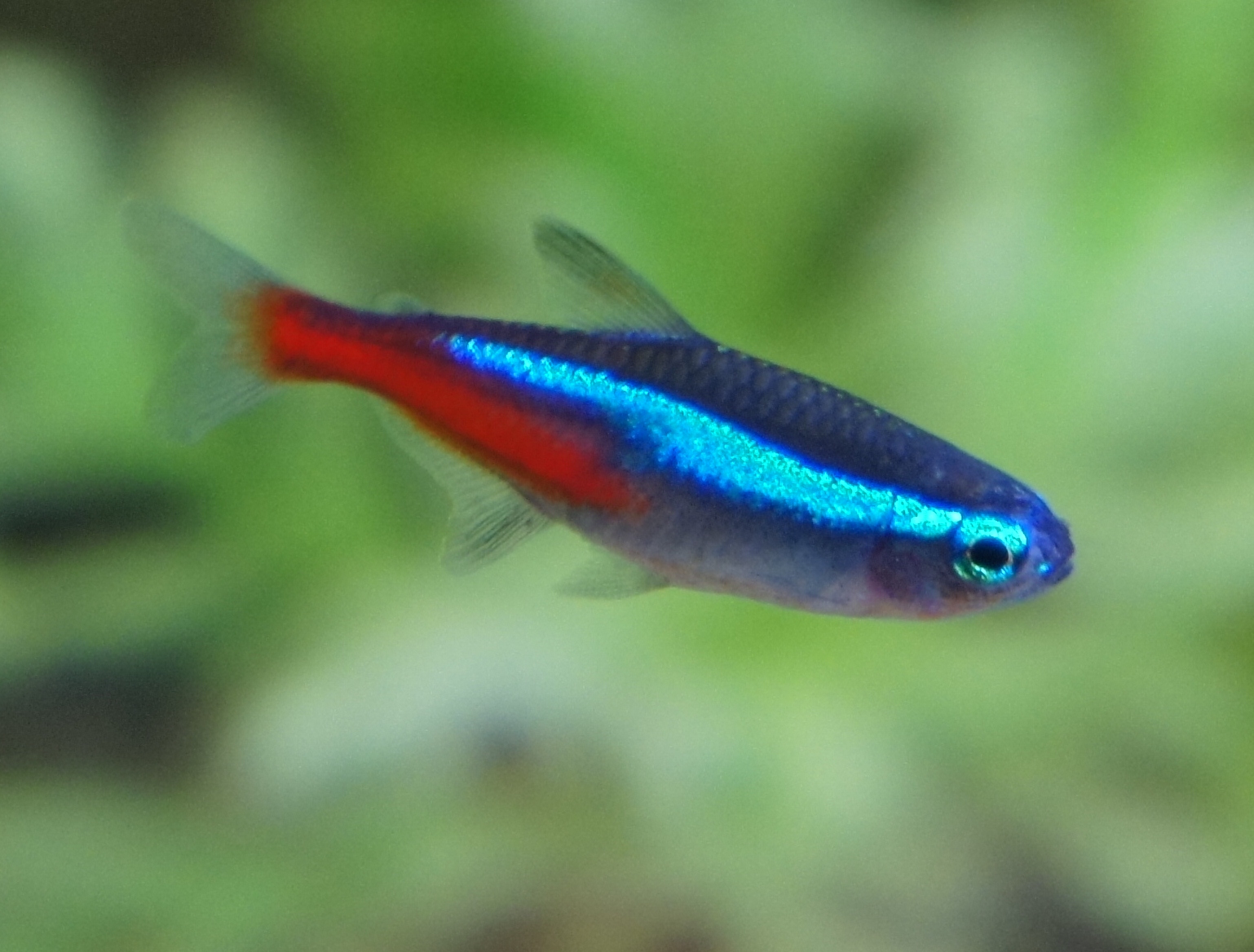Neon Tetra

An in-depth guide to the Neon Tetra, one of the aquarium’s most iconic and beloved inhabitants.
The Neon Tetra: A Tiny Gem of the Aquarium World
For decades, the Neon Tetra (Paracheirodon innesi) has been a cornerstone of the tropical fish hobby. Instantly recognisable by its dazzling, iridescent stripe, this small fish brings a vibrant flash of colour and activity to any community aquarium. Native to the blackwater streams of the Amazon basin, the Neon Tetra is a peaceful, schooling species that, with the correct care, can thrive and bring enjoyment to aquarists of all levels.
This extended guide will cover everything you need to know to provide the best possible care for these aquatic jewels, from setting up the perfect habitat to understanding their behaviour and health needs.
Natural Habitat and Origins
Understanding a fish’s natural environment is key to successfully keeping it in an aquarium. Neon Tetras originate from the slow-moving, acidic blackwater tributaries of the Orinoco and Amazon rivers in South America, primarily in Peru, Colombia, and Brazil.
These waters are stained tea-brown by tannins released from decaying leaves, wood, and other organic matter. This creates an environment with very soft, acidic water and subdued lighting due to the dense rainforest canopy above. Replicating these conditions is the best way to ensure your Neon Tetras feel secure and display their most brilliant colours.
Appearance and Lifespan
The Neon Tetra’s fame comes from its stunning and simple colouration. It boasts a brilliant, electric blue horizontal stripe that runs from its nose to the base of its adipose fin. Below this, a vibrant scarlet-red stripe runs from the middle of its body back to its tail. This striking colour contrast makes a school of Neons a breathtaking sight.
In a well-maintained aquarium, Neon Tetras typically live for 3 to 5 years. They are a small species, reaching an adult size of approximately 4 cm (1.5 inches).
Neon V Cardinal Tetra

While Cardinal and Neon Tetras look strikingly similar and are often confused, there are several key differences that are important for any aquarist to know. These differences relate not only to their appearance but also to their care requirements and hardiness.
Here is a detailed breakdown of the differences between the Cardinal Tetra (Paracheirodon axelrodi) and the Neon Tetra (Paracheirodon innesi).
Main Visual Difference: The Red Stripe
The easiest and most immediate way to tell these two species apart is by looking at the red stripe that runs along their lower body.
- Cardinal Tetra: The vibrant red stripe extends the full length of the body, from the eye and snout area all the way to the tail.
- Neon Tetra: The red stripe is shorter, starting from the middle of the body and running back to the tail. The area on the belly beneath the blue stripe is a silvery-white.
This key difference is the most reliable identifier. In Cardinals, the blue and red stripes run parallel along the entire body, whereas in Neons, the red stripe appears as a splash of colour on the latter half of the fish. Cardinal tetras tend to be the more hardier of the two species due to the many years of over breeding the Neons.
Setting Up the Perfect Neon Tetra Aquarium
Creating the right environment is the most critical aspect of Neon Tetra care. A thoughtfully set-up tank will ensure your fish are healthy, active, and stress-free.
Tank Size and Schooling
Neon Tetras are active swimmers and, most importantly, a shoaling species. They feel secure and exhibit their most natural behaviours when kept in groups.
- Minimum School Size: A minimum of 6 is essential, but a group of 10-15 or more is highly recommended. In larger groups, their schooling behaviour is more impressive, and any potential aggression within the group is spread out.
- Minimum Tank Size: For a small school of 6-8 Neons, a tank of at least 45 litres is recommended. For a larger, more comfortable school, a tank of 60 litres or more is ideal, providing ample swimming space.

Water Parameters
While commercially-bred Neons are more adaptable than their wild-caught ancestors, they still thrive in water that mimics their natural habitat. Stability is more important than chasing a perfect number, so avoid any sudden changes in parameters.
Here are the ideal conditions:
| Parameters | Ideal Range | Notes |
|---|---|---|
| Temperature | 21 – 27°C (70 – 81°F) | A stable temperature is crucial. Use a reliable aquarium heater. |
| pH | 6.0 – 7.0 | They prefer slightly acidic water but can adapt to neutral pH. |
| Hardness (GH) | 2 – 10 dGH | Soft water is best, reflecting their Amazonian origins. |
| Ammonia | 0 ppm | Must be undetectable. Cycle your tank fully before adding fish. |
| Nitrite | 0 ppm | Must be undetectable. |
| Nitrate | < 20 ppm | Keep nitrates low with regular partial water changes. |
Export to Sheets
Tank Setup: Substrate, Plants, and Lighting
To make your Neons feel at home:
- Substrate: A dark-coloured substrate, such as black sand or fine gravel, will help to reduce stress and make their vibrant colours pop.
- Plants and Décor: A well-planted aquarium is perfect. Live plants provide cover, help maintain water quality, and create a naturalistic environment. Tall plants like Java Fern and Amazon Swords, along with floating plants, can help to diffuse light.
- Driftwood: Adding bogwood or driftwood is highly recommended. It releases beneficial tannins that gently lower the pH and replicate the blackwater conditions Neons love.
- Lighting: Subdued lighting is preferred. Bright, intense light can cause stress and wash out their colours. If you have powerful lights for plant growth, use floating plants to create shaded areas.
Diet and Feeding
Neon Tetras are omnivores and are generally not fussy eaters. In the wild, their diet consists of small insects, crustaceans, and plant matter.
- Staple Diet: A high-quality micro-pellet or flake food should form the basis of their diet.
- Supplements: To ensure optimal health and colour, supplement their diet 2-3 times a week with frozen or live foods. Good options include daphnia, brine shrimp, and bloodworms (in moderation).
- Feeding Schedule: Feed small amounts once or twice a day. Only provide what they can consume within two minutes to prevent overfeeding and maintain water quality.
Behaviour and Suitable Tank Mates
Neon Tetras are a peaceful species, making them an excellent choice for a community aquarium. However, their small size means tank mates must be chosen with care.
Good Tank Mates Include:
- Other small, peaceful Tetras (e.g., Cardinal, Ember, Rummy Nose)
- Harlequin Rasboras
- Corydoras Catfish (an excellent bottom-dwelling companion)
- Dwarf Gouramis
- Kuhli Loaches
- Small, peaceful livebearers like Guppies and Platies
- Dwarf Shrimp (though they may eat the tiniest shrimplets)
Tank Mates to Avoid:
- Any large or aggressive fish that could view a Neon Tetra as a meal. This includes most Cichlids (like Angelfish, once fully grown), Oscars, and larger Barbs.
- Fin-nippers, which may harass the tetras.
Health and Common Diseases

While hardy, Neon Tetras are susceptible to certain conditions, most famously one named after them.
Neon Tetra Disease (NTD)
This is the most well-known ailment affecting this species.
- Cause: A microsporidian parasite (Pleistophora hyphessobryconis).
- Symptoms: Difficulty swimming, restlessness, a curved spine, cysts developing on the body, and a loss of colour, particularly in the blue and red stripes.
- Treatment: Unfortunately, there is no known cure for NTD. The disease is highly contagious and fatal.
- Prevention: The best strategy is prevention. Quarantine all new fish for at least 4 weeks before adding them to your main tank. Immediately remove any fish showing symptoms to prevent the parasite from spreading through cannibalism of the dead fish.
Other Common Issues
- White Spot (Ich): Caused by the Ichthyophthirius multifiliis parasite. Appears as small white dots, like grains of salt, on the fish’s body and fins. It is treatable with commercially available medications and by slowly raising the aquarium temperature.
- Fin Rot: A bacterial infection, often caused by poor water quality, that leads to ragged, decaying fins. Treatable with antibacterial medications and improved tank maintenance.
In Conclusion
The Neon Tetra has rightfully earned its place as one of the most popular aquarium fish in the world. Its beauty, peaceful nature, and active schooling behaviour make it a captivating addition to any home. By providing a stable environment that respects their natural origins—a well-maintained, planted tank with soft, clean water and a group of their own kind—you can enjoy the dazzling display of these tiny aquatic gems for years to come.


